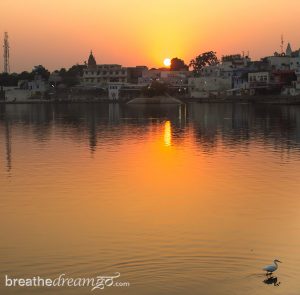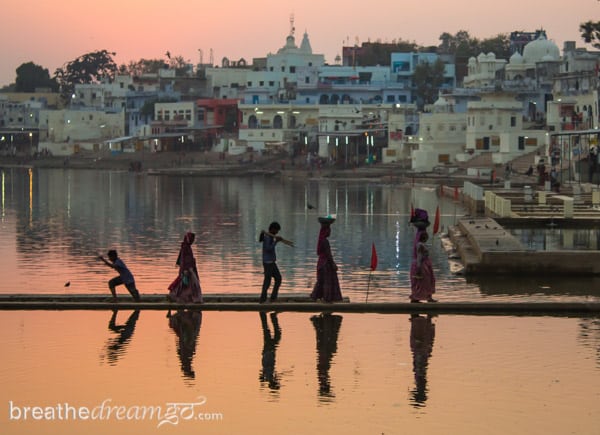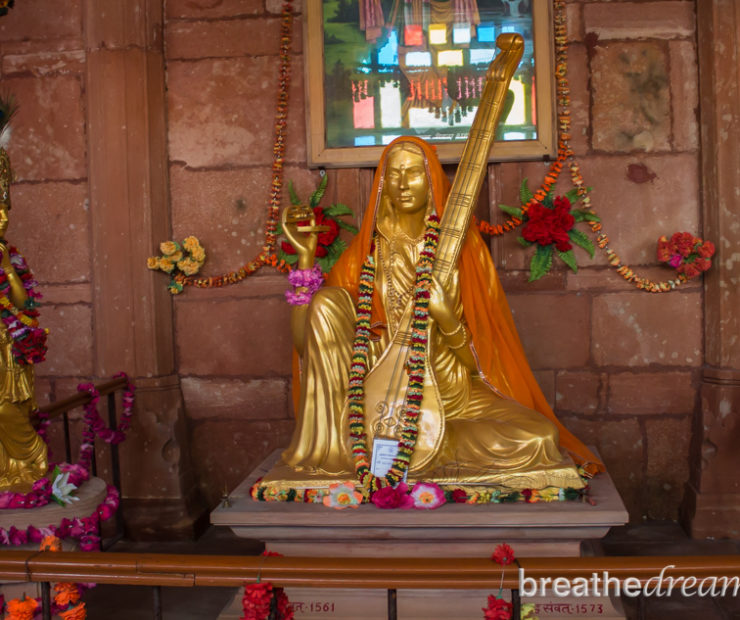Table of Contents
 Guide to the Pushkar Camel Fair
Guide to the Pushkar Camel Fair
Camels, crowds, culture, and conmen gather under the full moon in Pushkar, Rajasthan
UPDATED 2025: The Pushkar Camel Fair continues to celebrate the camel’s place in Rajasthan. It is only one of many camel fairs in Rajasthan (and not even the biggest), but it is the one that has become a tourist attraction. Yes, camel traders still do come here to do business, but not in the same numbers (and mostly before the fair even starts). And the tourism part of the fair — the ferris wheels, displays, competitions and cotton candy — have eclipsed the original purpose. It is said there are now more photographers than camels at the Pushkar Camel Fair.
Dates for the Pushkar Camel Fair 2025: Oct 30 to Nov 5.
I was attracted to the Pushkar Camel Fair by romantic ideas about camels and camel traders journeying across the vast deserts of Rajasthan in a time immemorial fashion to meet, socialize and trade. And indeed that is the historical truth of the Pushkar Camel Fair. There was a time in storied Rajasthan when camels were an integral part of every day life.
Camels were an agricultural mainstay; they supplied milk, leather and other products; they were elaborately decorated for weddings and other rituals. The romantic image of camels loping across the desert in Rajasthan is based in truth and fact. But, sadly, this way of life is waning as mechanization, water shortages and government policies against camel grazing are taking their toll.
The Pushkar Camel Fair is under the spotlight as the camel culture in Rajasthan continues to decline. Read more here: Has the Pushkar Camel Fair lost its magic? I also highly recommend that you check out CamelCharisma, a local organization run by people trying to help save the Raika and their nomadic culture.
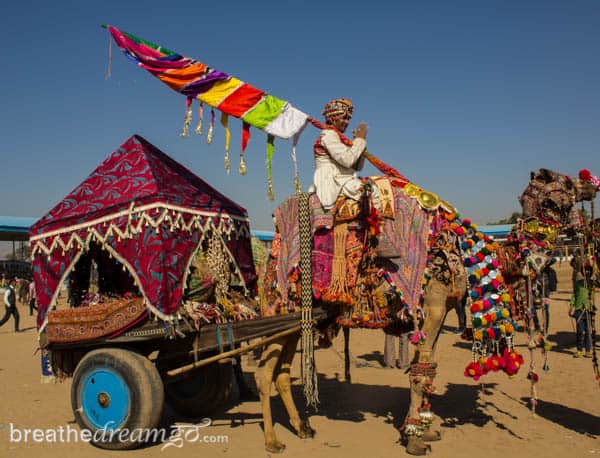
The Pushkar Camel Fair is also timed to coincide with the Kartik Purnima (full moon). At this time, Hindu pilgrims flock to Pushkar to take a dip in the sacred lake, which they believe will cleanse them of their sins.
Pushkar is the site of the only Brahma Temple in India, and the small town rings lovely Lake Pushkar, which is a deeply serene place to be at sunrise — and one of my favourite Incredible India experiences. However, during the five days leading up to Kartik Purnima, the small town of 15,000 swells to at least 250,000.
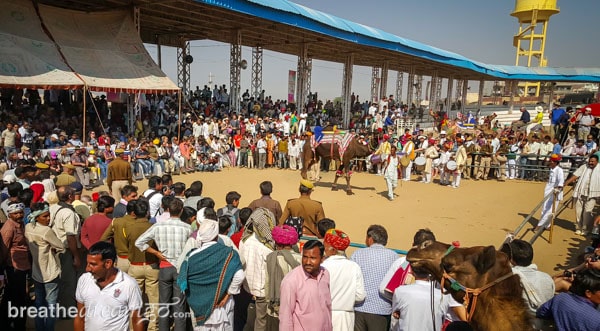
So, because of the combination of pilgrims, sadhus, camel traders, tourists and ubiquitous Pushkar hippies, the narrow market lane, ghats and mela (fair) grounds swarm with people, and the town’s usual serenity is lost in the melee. It’s still fun and interesting to be in Pushkar at this time, but beware that hotel rates go up (in some cases, way up), there are way more than the usual assortment of beggars, street kids, conmen and gypsies scamming for money and the authenticity factor of the fair may be lacking for some.
In the end, I enjoyed the town of Pushkar (as I always do), meeting some camel traders, attending a concurrent cultural festival called The Sacred Pushkar, taking part in spiritual rituals, and staying at the brand new Zostel hostel … but the Camel Fair … not so much. It mostly consisted of pale-skinned foreigners pushing and shoving each other to get a good camera angle for the camel decorating contest or the moustache competition or whatever. Poor organization meant that you had to jostle to see what was happening in the competition “pit.”
But for this post, I am highlighting two of the things I enjoyed the most.
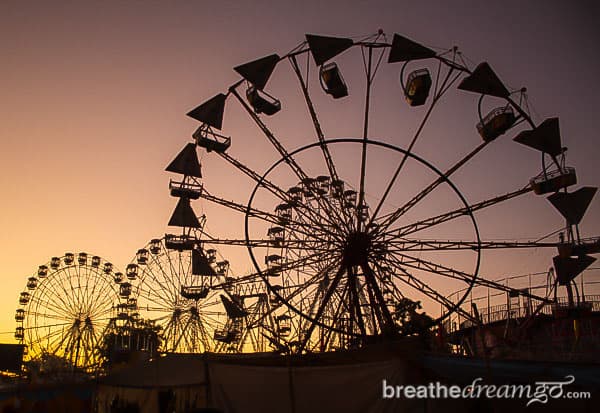
The camel traders at the Pushkar Fair
First and foremost, I wanted to hear from the camel traders themselves. So one morning early in the fair, I went out to the mela grounds and by luck or chance met Gopal. A local man, Gopal takes tourists around the fair on a cart pulled by his camel, Raj. While I wasn’t interested in hiring his camel taxi for touristic reasons, I did want someone to take me out into the desert, someone who could help me interview camel traders and translate. Gopal understood perfectly, so away we went, away from the fair, into the beautiful scrubby desert outside of Pushkar.
The first man we stopped, Ratnaram, was lean and taciturn, and reminded me of an American cowboy, like Gary Cooper in a kurtah. He had a green pagri (turban) wrapped around his head, deeply lined face and when I shook his hand, it was like touching the roughest sandpaper. The sand of desert parches the skin — even I noticed it in a few days, and lathered myself with oil after showering each day.
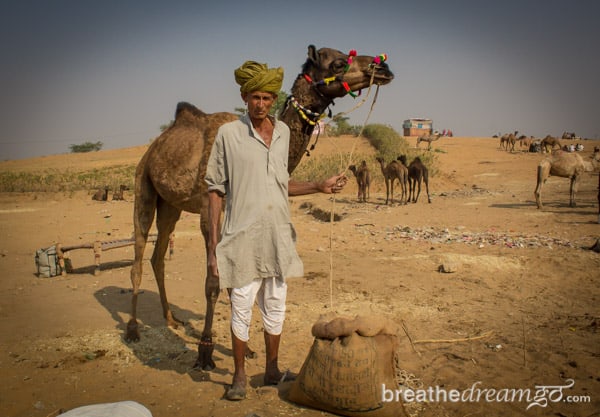
Ratnaram told me, through Gopal, that he brought five camels to the Pushkar Camel Fair and sold four. He was left with just one camel, a female named Shelly. He said he was happy with the price the camels fetched, and really enjoyed the Camel Fair. It’s the most famous, he said, it’s the best. But he doesn’t enter any of the competitions.
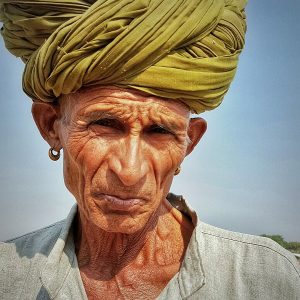
I was interested in finding out more about the life and prospects of a camel trader, and Ratnaram told me he doesn’t buy camels because of the Rajasthan drought. He still has 10 females and one male at home in his village, and will take most of these camels to the Nagur camel fair.
I also wanted to know who bought his camels, as I had heard many were bought by Muslims and slaughtered for meat. Ratnaram told me Hindus bought his four camels. Just at that moment, we saw a Muslim camel trader inspecting some nearby camels.
I thanked Ratnaram, and gave him 10 rupees to take his picture — the standard price at the Pushkar Camel Fair — and he obligingly posed for me.
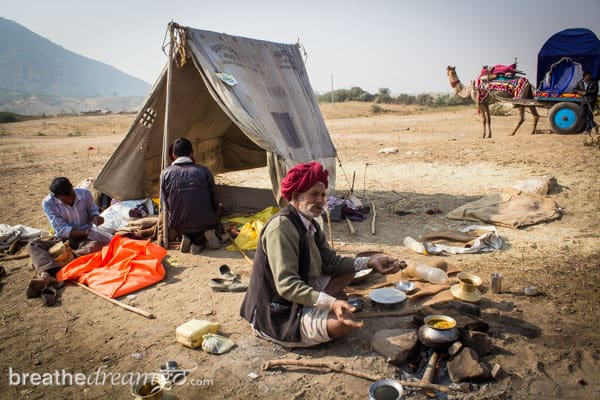
From there we moved out further into the desert, which was beautiful and peaceful, and met Kanaram. He was making a very delicious looking dish over an open fire, and was willing to talk to us, but wanted 250 rupees to take his photo. Kanaram brought 120 camels to the fair, and sold 40 to a business man who is going to use them for farming, he said. He pointed to some pregnant camels and a couple of baby camels.
I offered him 25 rupees, far above the standard rate, for his photo, but he declined and I walked away. Nearby, we met Ganpatram, who brought 15 camels to the fair and sold 7. He said he was happy with the price, and was generally happy with being a camel trader because his village has a well and they had good rains this year.
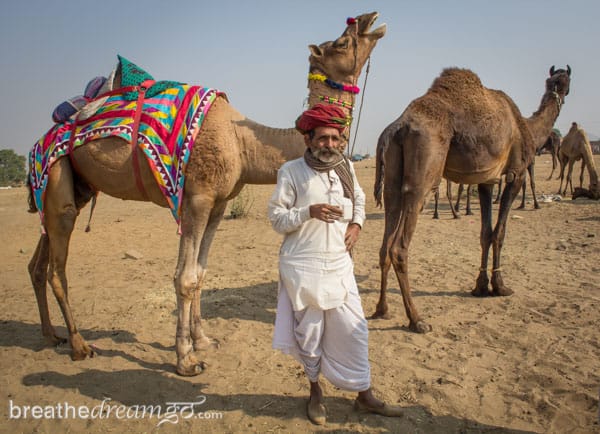
Ganpatram is a man with a twinkle in his eye, and he enjoyed posing for me with one of his camels. He said he really enjoyed the camel fair, and was thinking of entering the camel race competition for the first time. He twinkled even more when he said this, then we posed together, and I left him as the sun was casting long shadows on the desert.
I felt a great sense of satisfaction for having crossed the divide between tourists and camel traders, thanks to the adept skills of Gopal. Until this interaction, there was no exchange whatsoever, due in part to the language barrier but in larger part due to suspicion and skepticism. When I had walked through the camel grounds before, I heard only “money, money” from every local person I met. It was disheartening, though I understand their struggle to survive, and how they must feel about the onslaught of camera-toting tourists.
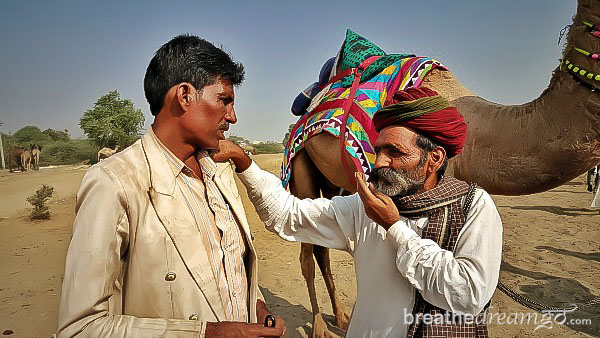
The Sacred Pushkar Festival of Music, Yoga and Meditation
During one of the busy religious rituals in Pushkar, I got caught up in a swarming crowd of pilgrims pushing through the narrow market lane towards the lake. To avoid the crowd, which was causing me some panic, I sprinted towards the much-less crowded ghats on the far side of the lake. A crew of people were setting up VIP seating, which blocked my way. I investigated and discovered they were setting up the first event of The Sacred Pushkar Festival of Music, Yoga and Meditation.
Just then, I caught sight of Sanjoy Roy, the energetic and personable managing director of Teamwork Arts, the company organizing The Sacred Pushkar. I had met Sanjoy at the Jaipur Literature Festival last January, and luckily he remembered me. He very kindly gave me an invite to the evening’s performance and put me on the guest list for the other events. So I left the ghats with a skip in my step, marveling at the way things change in India so fast, and how moments of magic happen out of nowhere.
That night, my colleague Derek Freal of The Holi Daze travel blog accompanied me to the first event, an evening of music on Raj Bohra ghat. We took our place on cushions behind the stage, and facing the lake, and settled in for an incredible night. The evening started with a Maha Aarti and Vedic chanting as the sun set. Afterwards, drummers from Rajasthan performed on a different ghat, and then the scene switched back to the Raj Bohra ghat for flautist Sunil Kant Gupta and singer Shubha Mudgal. Fireworks over the lake marked the end of an amazing night.
Six more events in and around Pushkar were lined up over the next three days and I managed to make it to two of them. The following night, Derek and I headed out to the sand dunes on the edge of town for a very different musical evening. This one was more like a concert and featured the Jaisalmer Boys, Pandit Vishwa Mohan Bhatt and pop singer Kailash Kher. It was also a great evening though perhaps less sublime than the music on the ghats. I especially like the music of Vishwa Mohan Bhatt, who invented the Mohan Veena and played with incredible intensity and mastery.
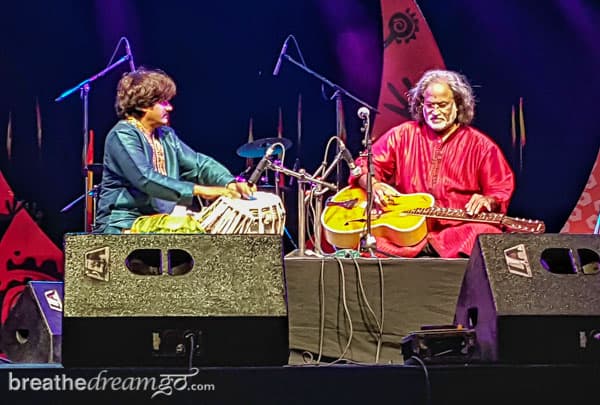
A heritage walk in Pushkar during the Fair
The following morning, I was walking through the market in Pushkar when Sanjoy Roy of Teamwork Arts appeared again, somewhat like the Mad Hatter in Alice in Wonderland, and swept me up with some others who were on their way to join the Heritage Walk. In fact, I had forgotten about it … but when Sanjoy asked if I was lost and looking for it, I said yes — as I had wanted to join in. So, I found myself on the ghats, along with about a dozen others, with Ravi Sharma of Roots of Pushkar Records as our guide. (Readers may remember Ravi as the man who helped me during The Mirabai Expedition when I was looking for the nearby Mirabai temple and museum.)
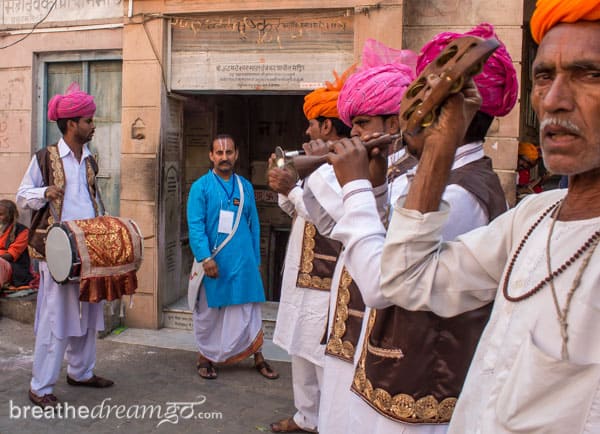
Rajasthani musicians played to get things started and accompanied us around the town as Ravi told stories about the town’s mythical and historical past. We learned that Lake Pushkar was created when Brahma dropped a lotus flower there, and that it’s the site of the only Brahma Temple in India because his wife Savitri cursed him after he married a local girl, Gaytri, for religious religions. Pushkar was the first place the Gaytri Mantra was recited, in honour of her.
For about two hours we walked around the lake as Ravi related stories and showed us ancient monuments and exquisite temples I never knew existed, despite having spent a considerable amount of time in Pushkar. Ravi explained how some of the ghats got their names, why Pushkar is famous for roses, and how the five days leading up to and including the full moon in the Hindu month of Kartik are by far the most powerful for gaining Brahma’s blessings. Even the Indian journalists who were on the tour were impressed by some of the things we saw and learned — particularly the Chandraghat Temple, the only moon temple in India.
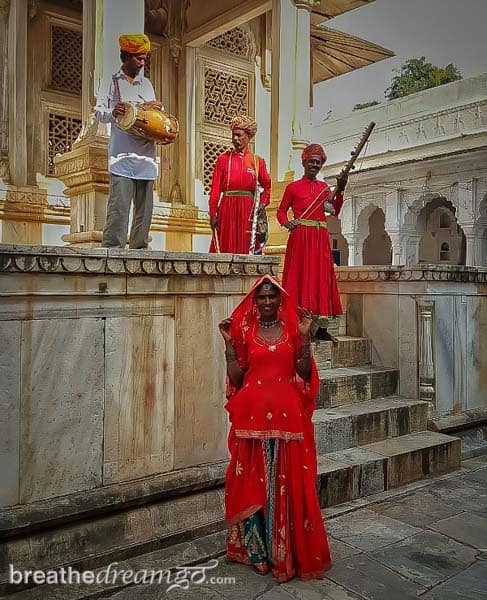
Like everything The Sacred Pushkar presented, the heritage walk was extremely well-organized and well-presented and rich with thoughtful substance. Sanjoy Roy told me it was planned to complement the Camel Fair, and add cultural depth and texture. It does that, they have definitely achieved the goal, and much more. In fact, it’s much better and more enjoyable than the touristy, elbow-butting, crowded and disorganized Camel Fair. I would plan to attend The Sacred Festival again, no question. But I have no desire to experience the Pushkar Camel Fair again.
At the end of the heritage walk, Ravi invited me to take part in a puja on Varah Ghat, where he is one of the presiding pandits. I went that night, and sat right at the front, next to the pandits, on the edge of the lake. I was fully immersed in the sacred element of Lake Pushkar, and felt elated by the energy. Likewise, on the full moon night, Derek and I hiked up to the top of Savitri mountain, to the temple, and watched the moon rise over the town below. These were some of the very special, spiritually oriented experiences that I love Pushkar for. The Camel Fair notwithstanding.
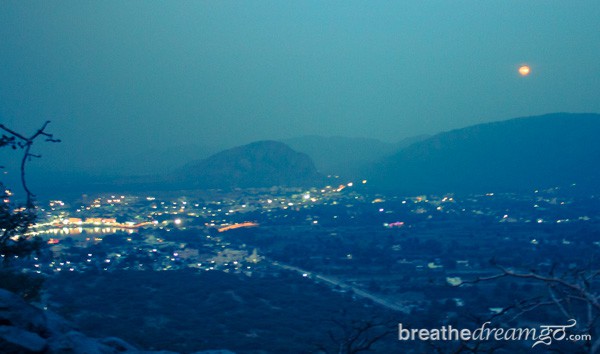
NOTE: I was a guest of Zostel Hostel and in Pushkar for the Camel Fair to help promote the new location. However, this arrangement did not, and will never, influence my opinion or my remarks. I write this blog with my readers firmly in mind at all times.
If you enjoyed this post, please sign up to The Travel Newsletter in the sidebar and follow Breathedreamgo on all social media platforms including Instagram, TripAdvisor, Facebook, Pinterest, and Twitter. Thank you!


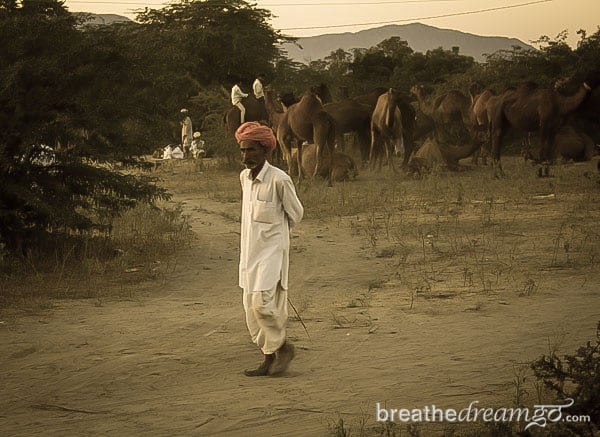 Guide to the Pushkar Camel Fair
Guide to the Pushkar Camel Fair